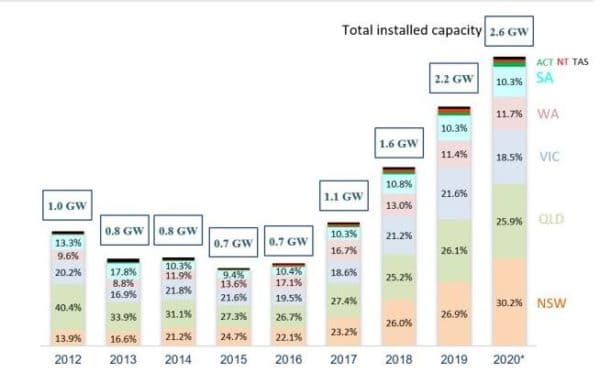A fortnight ago, Opposition Leader Anthony Albanese launched Labor’s electric vehicles policy, which aimed to reduce federal taxes and thereby increase the up-take of electric cars. Yet overshadowed in the announcement was a $200 million commitment to what are being called “community batteries”.
What are Community Batteries?
Community batteries are designed to make rooftop solar more effective and profitable while stabilising the electricity grid overall. Sitting in an intermediate position between grid-scale batteries and private, in-home batteries, community batteries aim to serve from a few dozen to several hundred local households. Depending on final regulations, they may also give apartment dwellers access to the cheap energy produced by rooftop solar panels.
According to the McKell Institute, Australia has the highest up-take of rooftop solar in the world. Approximately one in every five households have solar panels, with approximately 2.6 million units installed.
They now produce 13GW annually, energy equivalent to six large coal-fired power plants, or roughly the total coal-powered electricity generation of Queensland and Victoria combined. Last year saw a 39% year-on-year increase, contributing to a 16% increase in total energy generation nation-wide last year

Yet most households gain less economic benefit from rooftop solar units than they could, because they feed energy into the grid during the day then have to buy it back in the evening. Community batteries are intended to make more households self-sufficient in electricity. In doing so, they also increase the economic benefit for further rooftop solar installations.
Batteries have come a long way since being mocked by Scott Morrison in 2017. “It is so at the margin it barely is worthy of a mention,” said Morrison at the time, in response to the announcement of South Australia’s Tesla “big battery.”
“I mean, honestly, by all means have the world’s biggest battery, have the world’s biggest banana, have the world’s biggest prawn like we have on the roadside around the country, but that is not solving the problem.”
With battery production costs falling year-on-year and AGL signalling that battery storage will out-compete gas peakers in satisfying peak electricity demand, Morrison couldn’t have got it more wrong.
Follow Christian on Twitter for more news updates.